
Probably 95% of all aquariums in the hobby are just fine with just a very easy maintenance regimen. But if one looks up stocking ratio apps and websites and does the inputs into those sites AND those sites say you are over 100% stocked or over, i.e. overstocked, one CAN have a problem. ONLY if one has very heavily stocked aquarium with only moderate amounts of biofiltration one should read on. This analysis is very long and boring.

The Extreme Case
To any observation there will always be an exception. ANY filtration system CAN be overloaded. With heavy stocking of an aquarium and moderate or poor filtration one can rarely get into a problem with hypoxic conditions. An example from aquaculture is informative.
In a pond which is used to raise juvenile fish like Tilapia for human consumption or ornamental fish like Lake Malawi cichlids, a brown mulm will form on the bottom over the span of a year or so. And the fish will start having all sorts of problems. These operations typically have to clean off the bottom of the ponds every year or so. The brown mulm which forms is very organic and oxygen conditions get low, into what is called the “hypoxic” range of 0.3 to 2 ppm. Under these conditions bacteria and organic compounds can be released which severely negatively affect the fish.
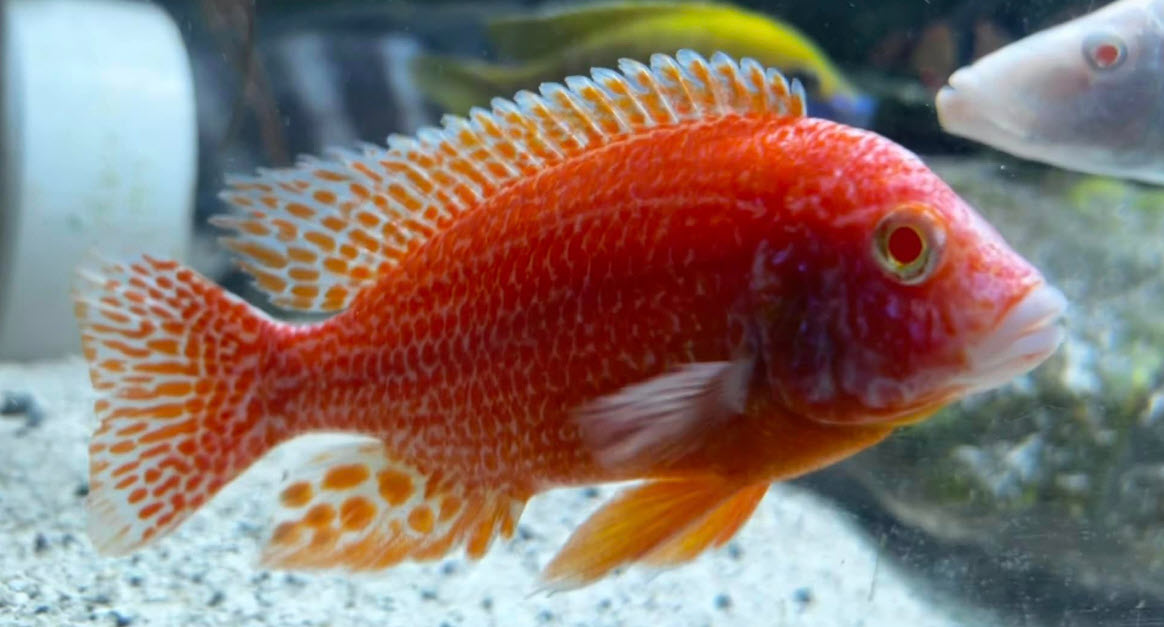
But these ponds have some serious drawbacks:
- The stocking is typically three times what we define in an aquarium as “heavy stocking”, nine times “maximum 100% recommended stocking” and thirty times “light stocking”
- The aeration is typically nonexistent
- The substrate is very fine soil
- There typically is no biofiltration
- They feed their juveniles at a rate of 6% of body weight, which is twice the maximum level we recommend.
So is it possible for an aquarium substrate to “go bad” and affect the fish? Yes it is “possible”. But it is highly unlikely.

The Human Nose Test
The hypoxic (“low oxygen” levels) that produce damaging organic compounds always produce one other thing, a smell which lies somewhere between rotting food and sewage. So any time one has the huge need to clean the substrate, just smell the aquarium while your doing the cleaning. If you only have no smell or an “earthy” smell you are just fine. But get a “sour”, rotten food, or sewage smell and you have no dead fish or dead snails, one will need to transfer the fish to another container and do a thorough cleaning and tear down on the aquarium, leaving only the media in the filter uncleaned.
The conditions that produce an hypoxic substrate typically include some combination of:
- overstocking
- fine sand substrate
- no pond mud inoculate
- little aeration
- low protein food
- heavy feeding
- low water movement
Very rarely some combination of these factors can create hypoxic conditions in the substrate which release irritating chemicals into the water column and affect the fish.

An Example:
I had a question and answer in the comments section on this website which I think illustrates hypoxia in a substrate perfectly. So I’ll just repeat the exchange here:
Jim Mc
I would like to run something by you concerning hypoxia in the aquarium. For years I had issues in my 265 gallon African cichlid tank with the fish flashing constantly to the point they would injure themselves. They also would have what I can only describe as a spasm of some sort where their body would twitch, fins quiver and dart around the tank. Some fish exhibited this behavior more than others, usually the smaller or less dominant fish. I tried every medication or remedy I could find over the years thinking I was dealing with some sort of external parasite. Obviously, I would do a treatment for the recommended period of time then add carbon and do a large water change before I tried something else. Nothing worked. I finally came across a local veterinarian who had experience with all sorts of exotic animals, including fish. I brought one of my yellow Labidochromis to him. He clipped a sample of the gills and also took a skin scrape and couldn’t find anything noteworthy.
I decided to have a full necropsy done on the fish through Cornell University. Results came back negative for anything parasitic, bacterial or fungal. I thought maybe I didn’t bring him a specimen that was fully symptomatic so I tore my tank apart to catch three more fish that I knew had persistently exhibited the flashing and spastic behavior. 3 more necropsies done and no significant findings from any of them. At this point, I know it has to be something in the tank that is causing it. I have two other tanks with African cichlids with the same water quality and no issues. The only objects in the tank are a couple hundred pounds of lace rock, some artificial plants, pool filter sand and eggcrate that I had placed underneath the rocks to help distribute their weight and provide support.
Fast forward a couple months to July 2021 and my tank starts leaking from a corner. I do a full tear down and eventually rehome the majority of yellow labs and move the rest of my haps and peacocks into a new 125. When I had the 265 almost fully drained there was a horrible stench similar to what you described as sewage in your article. There was sand caked solid in the holes of eggcrate that was dark brown in color, much darker than the normal, whitish appearance of the pool filter sand. It has been 7 months since the fish have been in the 125 and they have yet to display the flashing or spastic behavior. From the information I have given you, would you feel comfortable confirming I had a hypoxic substrate and that’s what could be causing the behavior I was seeing?
I would also like to note I never experienced many fish deaths over this time, maybe one or so a year. My thought was because I frequently changed large amounts of water the toxins weren’t prevalent throughout the tank at high levels and I also never moved the rocks, sand or eggcrate during this time. As noted earlier, it seemed that juvenile and less dominant fish were affected more than adult, dominant fish so perhaps their immune system was more stressed making them more susceptible to the bacterial toxins. Thanks again.
.
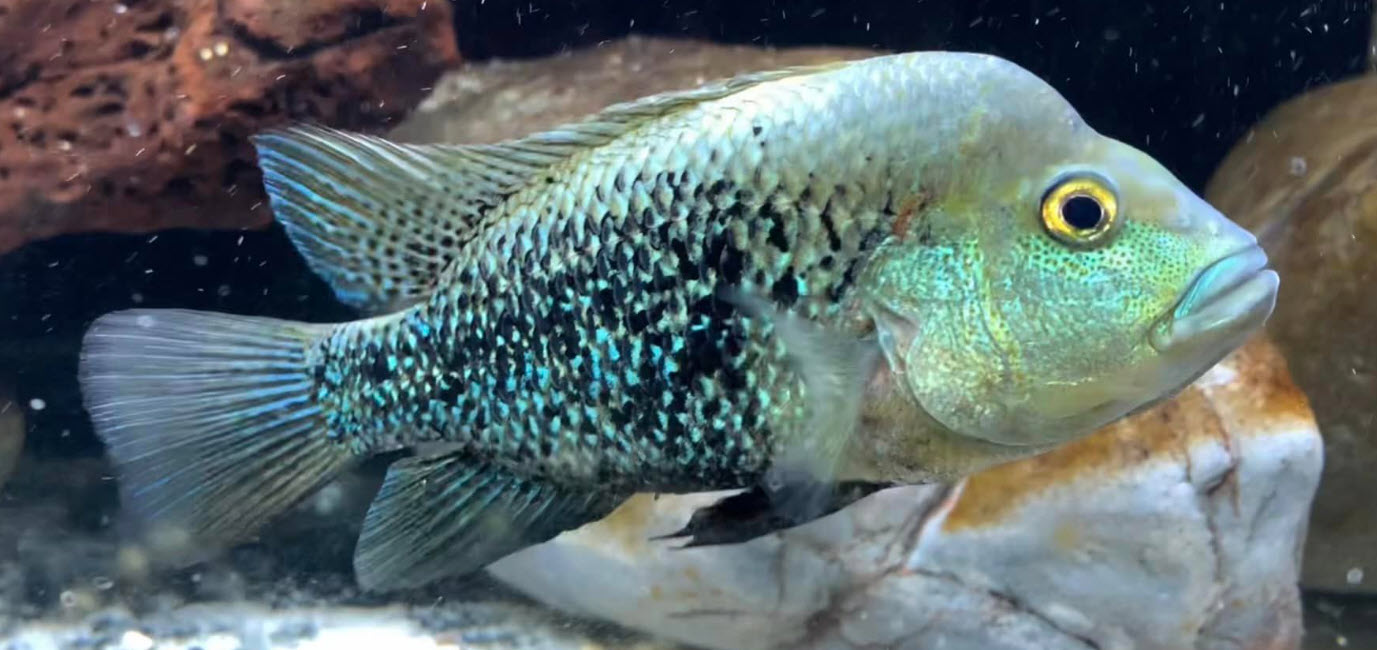
Dave
In reply to Jim … Sure sounds like it. That sewage stench is a dead give away. I’d be interested in some points. Do you think the stocking was heavy? Was the aeration good? Could you have been overfeeding? Any indication the food was low in protein? I’m trying to understand the conditions that will give a hypoxic substrate.
.
Jim Mc
Dave, definitely overstocked for sure. About 60 yellow labs ranging from fry to full grown adults, ten 4- 6 inch haps and peacocks, 4 large clown loaches 6- 9 inches, six 5 inch synodontis multipunctatus and 2 bristlenose plecos. I would say I have a heavy hand when feeding as well. The food was a combination of NLS, Northfin and Extreme so I believe all less than or about 40% protein. That was before I found your site. I have since switched to the Lakeway Tilapia feed that you recommend. I had 3 Fluval FX5’s and a large sponge filter as well as 2 wavemakers, one on each side. I added the wavemakers and sponge filter because I didn’t believe I and enough aeration or movement. I know the lace rock trapped a lot of food and feces as well due to all the crevices. Definitely not enough movement on the substrate as feces would collect in certain spots.
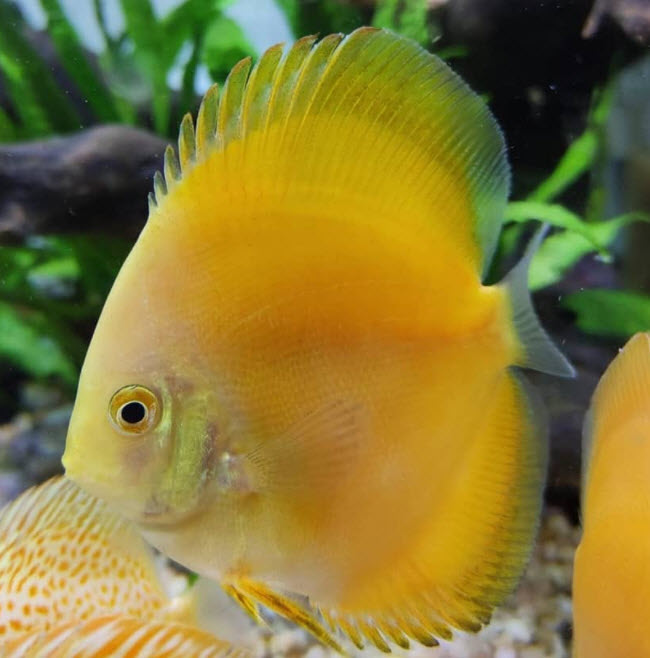
It is not easy to get hypoxic conditions. Take the deep sand bed aquariums of Father Fish. Some of these aquariums are full of very healthy fish, i.e. heavy stocking. Father Fish mixes up a mix of very rich materials like blood meal and composted manure. He then puts this mix down as a one inch layer beneath three inches of fine grained sand. He leaves these beds undisturbed for up to ten years. His beds are all deep black color below one inch in depth. When Father Fish tore down some of these tanks he reported that there was no discernable odor at all. Not even an earthy smell. This is very telling.
So even Father Fish’s deep sand beds did not have hypoxic conditions. Because of diffusion, Brownian movement, plant roots and the movement of organisms up and down, small amounts of oxygen will still get down to the bottom of this substrate. It is just very difficult to actually stop all oxygen permeation in only three to four inches of substrate.
Father Fish’s tanks had several things going for them. The water movement, aeration and biofiltration were excellent. They were inoculated with pond mud, which has all sorts of organisms in it which constantly “turn over” the substrate. Father Fish’s tanks also had plants. Many plants have evolved all sorts of mechanisms for introducing oxygen to their roots to allow them to survive in low oxygen conditions. Some of this oxygen will diffuse into the surrounding substrate.
And Father Fish is the poster child for not overfeeding fish. He constantly preaches to newcomers to stop feeding so much.

Hypoxic Conditions in More Depth
If one has an overstocked aquarium with moderate or low biofiltration one can get hypoxic conditions. These hypoxic conditions can give low grade damaging organic emissions which create health problems with the fish. These problems include mycobacteriosis (“Fish TB”), bacterial infections, and hole-in-the-head. There CAN be a general “failure to thrive”. Anything above the “Recommended 100% level stocking” below (the yellow columns) can create problems in SOME cases. It needs to be emphasized that this is rare in a well filtered aquarium.
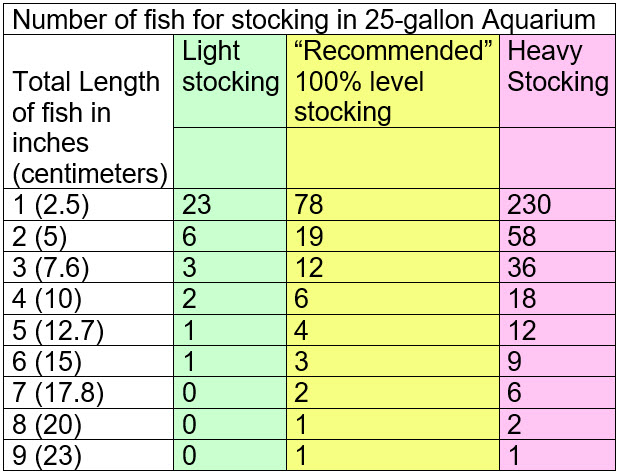
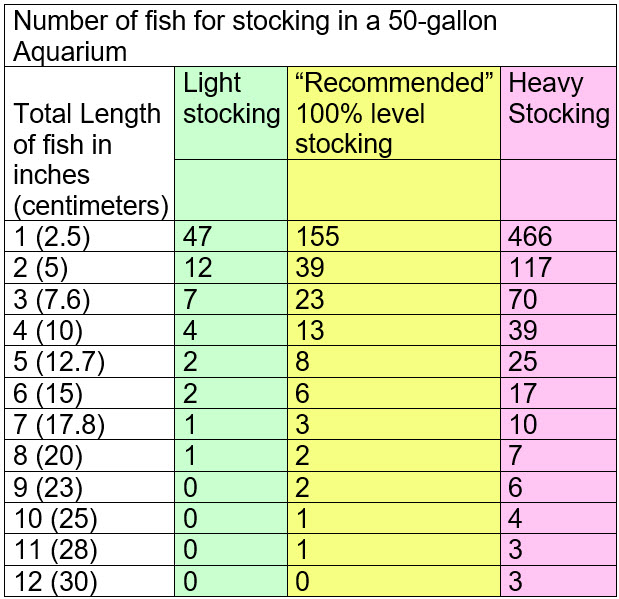
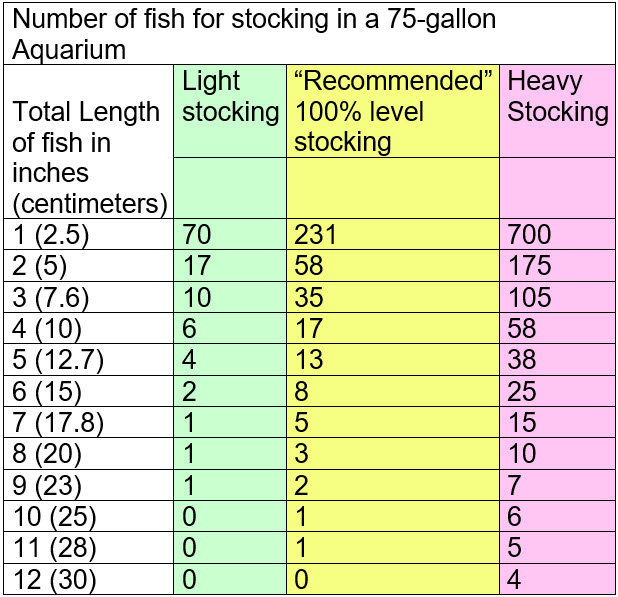
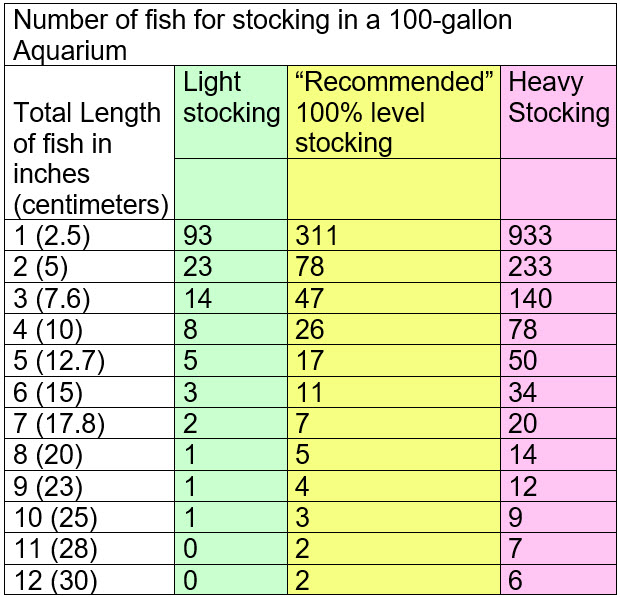
If you have, say, 25 five-inch Lake Malawi Peacocks in a 50-gallon aquarium, i.e., heavy stocking, things get a lot more complicated. A five-inch fish has a metabolic weight of 82 grams, or roughly 40 grams per gallon in our example aquarium. A lightly stocked tank will only have 4 grams per gallon while a “maximum recommended” aquarium will have 12 grams per gallon. This 40 grams per gallon CAN in SOME CASES produce some challenges. To look at these challenges it is best to have a scoring system.

.
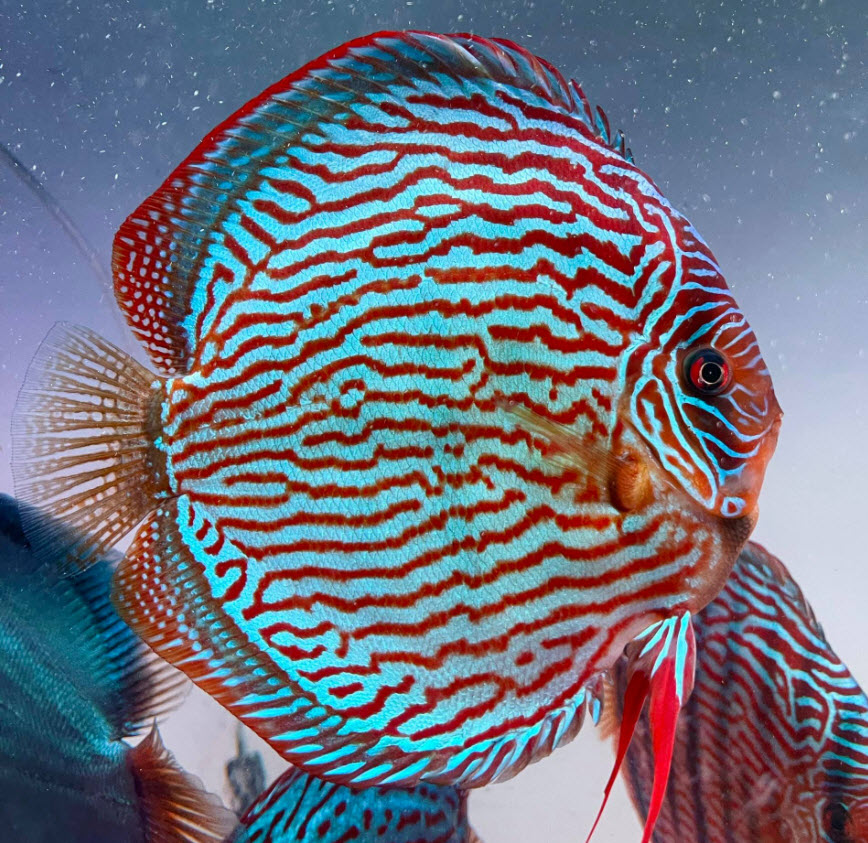
.
So what about one of my heavily stocked Lake Malawi Aquariums? So for our heavily stocked tank what is the score?

Now the higher the score the healthier the fish will be. VERY generally anything over 40 points will be good WITH HEAVY STOCKING. Obviously I am far from being in any trouble with my aquarium, even though I have very heavy stocking.
If you have light stocking this point system is totally unnecessary and will just give one a headache. In between these two extremes, what I call “moderate stocking”, sometimes this is useful and sometimes it isn’t useful. Note that with any natural system with a lot of variables the whole thing becomes very unpredictable. This is definitely the case here. It is useful to look at each of these variables separately:
Substrate
With heavy stocking the size of the substrate becomes important. The finer the substrate the less oxygen can penetrate the substrate. With light stocking and thus light feeding this is no problem at all. But add a heavy load of fish and this lack of oxygen can create hypoxic areas where bad organic compounds are produced.

Aeration
The more oxygen in the water the less likely hypoxic conditions will be created in the substrate.
Flow Across the Substrate
The higher the flow of water across the substrate the less likely there will be hypoxic conditions.
Fish
Discus keel over and die in bad conditions. They are a very sensitive fish, as are all the black water fish. Common goldfish seem to thrive in horrible conditions. Most fish are somewhere in between.
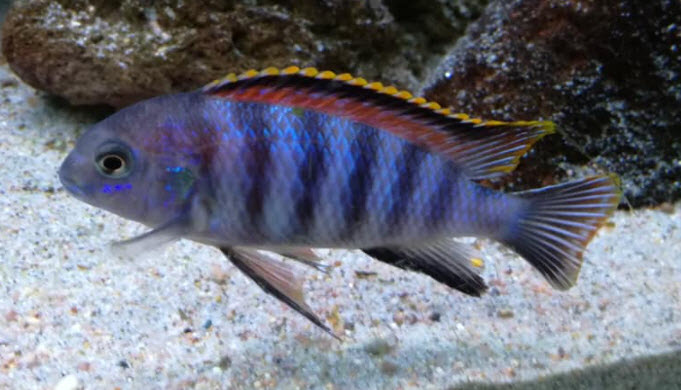
Filter Size
A small cartridge hang on back filter simply isn’t a big enough filter to handle a heavily stocked 50 gallon aquarium. An FX6 canister, on the other hand, will handle the load because of it’s large volume inside and the large amount of foam in the filter. Foam is simply the best stationary biofiltration media there is.
Food Protein Level
The higher the protein level of the fish food the less the brown gunk in the substrate and filter will build up in the aquarium. At 30% protein the brown gunk can very rapidly build up. At 55% protein in the food there often is no build up what so ever, the rate of decomposition is equal to the rate of addition.
Amount of Food
Obviously the more food added to the aquarium the more likely hypoxic conditions can form in the substrate.
Media
Ceramic rings, Matrix and lava rock in a canister won’t cut it. Foam, pot scrubbers and static K1 media are five times better media.
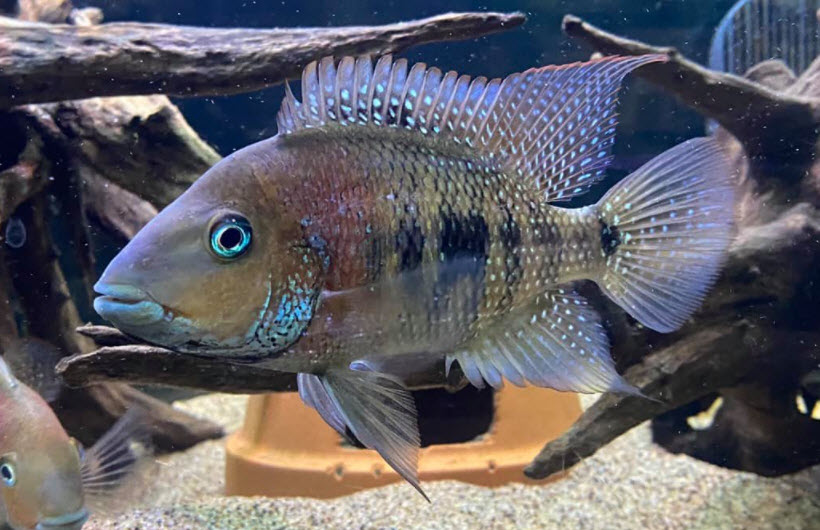
Maturity of Tank
An aquarium which has been set up for a month simply doesn’t have the natural systems working at full blast. It won’t handle a heavy load of fish. An aquarium which has been set up for six months with only partial and careful cleaning of the substrate and filter media will have mature natural systems which can handle most everything thrown at them.
Inoculate
For heavily stocked aquariums I recommend using Father Fish’s inoculate of mud from a local pond. What pond mud does for an aquarium is called “diversity”. When there are a host of little crustaceans and worms moving up and down through the substrate eating the brown gunk and decomposing it, there will be far fewer bad organic compounds built up.
Filter Cleaning
It is important to only do a partial cleaning of the filter media when the flow through the filter slows down noticeably. All filters, including under gravel filters, have adequate flow. This flow is normally enough to prevent hypoxic conditions from forming anywhere in the filter or filter media. So all the “brown gunk” in such a filter will be “good brown gunk”. It is beneficial to preserve this brown gunk. But if there is too much brown gunk, the flow slows through the filter and hypoxic conditions can form.

“Plugging” of an Undergravel Filter
Note that the same combination of things which will lead to hypoxic conditions in sand substrate can lead to “plugging” of an undergravel filter. If all or most of the conditions above are met an undergravel filter can plug up with brown gunk and stop functioning. And if an undergravel filter plugs it could POSSIBLY, IN THEORY go hypoxic.
Again, this would be an extreme condition. I have NEVER had an undergravel filter plug up. And I ran ten tanks with VERY heavy stocking and under gravel filters. And I have had these under gravels for some ten years in these tanks with no cleaning at all. But ANY filter system, no matter how good, can be overloaded and create problems.
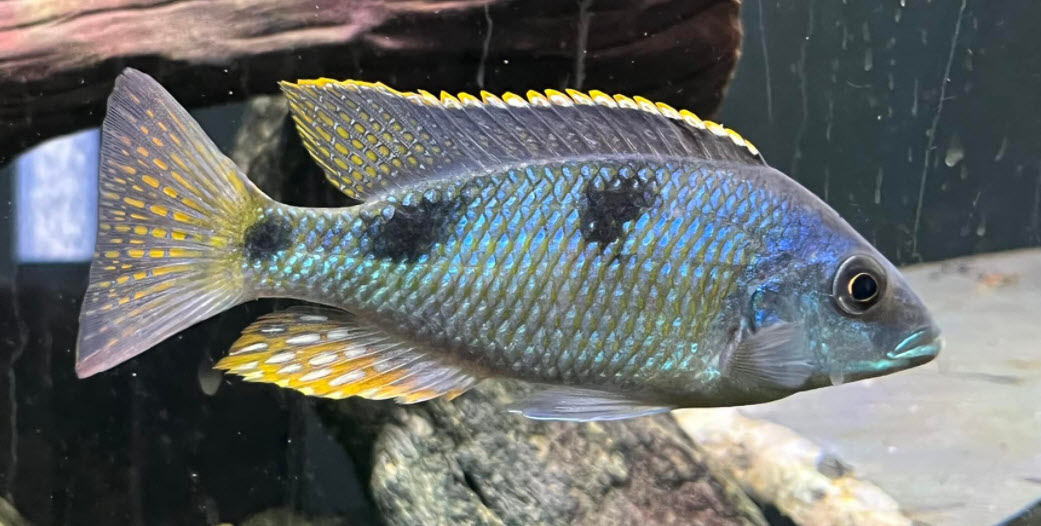
Maintenance of an Hypoxic Aquarium
If one suspects an hypoxic aquarium because of something like a bad smell in a heavily stocked aquarium, it is not time for half measures. The fish need to be transferred to other aquariums or even just buckets and tubs. All the hypoxic aquarium has to be torn down and cleaned thoroughly. This includes the substrate. Since it is virtually impossible for any functioning filter to go hypoxic one can leave the filter media untouched.
If for some reason one is forced to have an aquarium which might get hypoxic conditions, one needs to clean the substrate thoroughly at least once a month. One needs to feed very lightly. Adding pond mud will be very beneficial. But obviously a better (and easier) solution is to just add much better biofiltration and aeration.

Further Data
We go into all aspects of maintenance in the following links:
18.1. Aquarium Water Changes
18.2. Drip Water Changes
18.3. Cleaning the Substrate
18.4. Cleaning the Filter
Return to Maintenance Menu
.
Aquarium Science Website
The chapters shown below or on the right side in maroon lead to close to 400 articles on all aspects of keeping a freshwater aquarium. These articles have NO links to profit making sites and are thus unbiased in their recommendations, unlike all the for-profit sites you will find with Google. Bookmark and browse!
.

tess knoblich says
Thank you for incredibly frank, wise advice! Not in the least boring!! I was fascinated with entire article. I have 3, 6.7 gallon with heavy stocking. Each tank: Guppies 35+, 6 Otocinclus, 7-10 Ramshorns and one tank with 20+ Snowball Neo’s. gravel bottom just to cover, all live plants [many] either floating OR attached to lava rock or Cholla. Even heavy feeder water Lettuce. I do NOT dose any fert, have full spec light on 6-10 hrs per day [not high tech but they are on North side of house near glass slider so lots of natural no direct sun light]] a bubbler and NO other filtration. All have been doing very well, plants grow like crazy, all stock thriving. Rimless tanks no cover, heaters set to 77. No water changes just top offs. The oto cat and snails are always moving and twisting gravel, cleaning plants and tank surfaces. Guppies are wonderful eager eaters always foraging tank for scraps. I have no algae issues and IF I see a tiny green spot, I remove it post haste and cut light back for few days. When I started these tanks I did not cycle, instead I used Prime with my mildly hard tap water and added Stability every day for 2 weeks [Seachem recommends 1 week] and had no issues whatsoever. I top water once a week or so and add a dose of Stability a few times a month. I don’t vac gravel. I am very happy with my setups, all are thriving. I love Father Fish 🙂 I didn’t do exactly what he teaches but for me this has worked well.